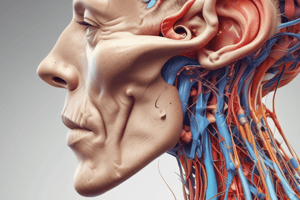Podcast
Questions and Answers
What is the main function of buffers in a solution?
What is the main function of buffers in a solution?
- To decrease the pH when bases are added
- To resist changes in pH when acids or bases are added (correct)
- To convert acids into bases
- To increase the pH when acids are added
Which of the following is NOT a cause of respiratory acidosis?
Which of the following is NOT a cause of respiratory acidosis?
- Chronic obstructive pulmonary disease (COPD)
- Acute kidney failure (correct)
- Hypoventilation
- Pneumonia
Which buffer system involves the binding of hydrogen ions to hemoglobin?
Which buffer system involves the binding of hydrogen ions to hemoglobin?
- Hemoglobin buffering system (correct)
- Phosphate buffer system
- Protein buffer system
- Carbonic acid-bicarbonate buffer system
In the context of acidosis, what compensatory mechanism occurs in response to respiratory acidosis?
In the context of acidosis, what compensatory mechanism occurs in response to respiratory acidosis?
What is a common cause of metabolic acidosis?
What is a common cause of metabolic acidosis?
Which buffer system involves the combination of carbonic acid and bicarbonate ions?
Which buffer system involves the combination of carbonic acid and bicarbonate ions?
What is the main cause of acidosis according to the text?
What is the main cause of acidosis according to the text?
Which type of acidosis is associated with failure of the lungs to excrete CO2?
Which type of acidosis is associated with failure of the lungs to excrete CO2?
Which buffer system is specific for buffering CO2 or H2CO3 produced by oxidation in tissues?
Which buffer system is specific for buffering CO2 or H2CO3 produced by oxidation in tissues?
In the context of biological molecules, what effect does the charge or neutrality of groups of atoms have on the molecule's biological activity?
In the context of biological molecules, what effect does the charge or neutrality of groups of atoms have on the molecule's biological activity?
What are the two main types of buffers mentioned in the text?
What are the two main types of buffers mentioned in the text?
How do buffers help maintain the pH of blood and tissue around 7.4?
How do buffers help maintain the pH of blood and tissue around 7.4?
What happens when a strong acid like HCl is added to the carbonic/bicarbonate buffer system?
What happens when a strong acid like HCl is added to the carbonic/bicarbonate buffer system?
What is the primary function of physiological buffers in metabolic reactions inside the body?
What is the primary function of physiological buffers in metabolic reactions inside the body?
How does a weak acid and its salt with a strong base buffer system act against pH changes?
How does a weak acid and its salt with a strong base buffer system act against pH changes?
Study Notes
Buffers
- Buffers are solutions that resist changes in pH when moderate amounts of acids or bases are added, maintaining a constant hydrogen ion concentration.
- Importance of buffers: biochemical reactions are sensitive to pH, and most biological molecules contain groups of atoms that can be charged or neutral depending on pH, affecting biological activity.
Composition and Types of Buffers
- Two main types of buffers:
- Weak acid and its salt with strong base (e.g., Acetic acid / Na acetate mixture, Carbonic acid / Na-bicarbonate mixture)
- Weak base and its salt with strong acid (e.g., Ammonium hydroxide / ammonium chloride mixture)
Mechanism of Action of Buffers
- Example: H2CO3 / NaHCO3 buffer system
- Addition of strong acid (HCl) reacts with bicarbonate, forming NaCl and H2CO3, neutralizing the strong acid and minimizing pH change.
Physiological Buffers
- Importance: maintaining blood and tissue pH around 7.4, suitable for most body enzymes' functions.
- Four physiological buffer systems:
- Carbonic / bicarbonate system (H2CO3 / BHCO3)
- Acid phosphate / alkaline phosphate system (BH2PO4/ B2HPO4)
- Acid protein/ proteinate salt system (H-proteinic acid/ Bproteinate)
- Hemoglobin/ oxy hemoglobin system (specific to red blood cells, buffering CO2 or H2CO3 produced by tissue oxidation)
Acid-Base Imbalance
- Acidosis: condition with decreased BHCO3/H2CO3 ratio (less than 20/1), pH range 7.35 – 7.45
- Causes of acidosis:
- Addition of acids
- Loss of large amounts of bases
- Failure to excrete H2CO3 by the lungs
Types of Acidosis
- Respiratory acidosis: failure of the lungs to excrete CO2 (H2CO3), often due to:
- Extensive lung diseases (e.g., severe bronchial asthma, emphysema, massive pneumonia, asphyxia)
- Depression of the respiratory center by toxins (e.g., morphia)
- Metabolic acidosis: various causes, including:
- Diabetic ketoacidosis
- Lactic acidosis
- Renal failure
Studying That Suits You
Use AI to generate personalized quizzes and flashcards to suit your learning preferences.
Description
Test your knowledge on blood buffers, acid-base imbalance, and related topics from the lecture by Prof. Hanan H. Fouad in the Medical Biochemistry & Molecular Biology course at Galala University. This quiz covers concepts that help you identify types, components, and mechanisms of blood buffers and acid-base imbalances.




